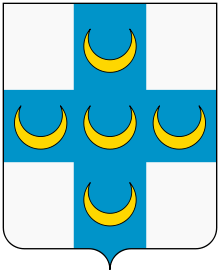Piccolomini

Piccolomini (pronounced [pikkoˈlɔːmini]) is the name of an Italian noble family, which was prominent in Siena from the beginning of the 13th century till 18th century.[1]
History
In 1220, Engelberto d'Ugo Piccolomini received the fief of Montertari in Val d'Orcia from the emperor Frederick II as a reward for services rendered. The family acquired houses and towers in Siena as well as castles and territory in the republic, including Montone and Castiglione; the latter sold to the commune in 1321.[1]
They obtained great wealth through trade, and established counting-houses in Genoa, Venice, Aquileia, Trieste, and in various cities of France and Germany. Supporters of the Guelph cause in the civil broils by which Siena was torn, they were driven from the city during the time of Manfred of Sicily and their houses demolished; they returned in triumph after the Angevin victories, were expelled once more during the brief reign of Conradin, and again returned to Siena with the help of Charles of Anjou. But through their riotous political activity, the Piccolomini lost their commercial influence, which passed into the hands of the Florentines, although they retained their palaces, castles and about twenty fiefs, some of which were in the territory of Amalfi and of great extent.[1]
Another branch of the family obtained a great success in the Kingdom of Naples, becoming one of the "seven great houses"[2] of the kingdom.
Prominent family members
Many members of the house were distinguished ecclesiastics, generals and statesmen in Siena and elsewhere.[1]
Two of them became popes:[1]
Other distinguished members include:
- Joachim Piccolomini (1258–1305), beatified Sienese
- Antonio Piccolomini, First Duke of Amalfi (d. 1493), a nephew of Pope Pius II and brother of Pope Pius III.
- Alfonso I Piccolomini, Duke of Amalfi (d. 1498), son of Antonio and duke from 1493, hapless husband of Giovanna d'Aragona, Duchess of Amalfi, granddaughter of Ferdinand I of Naples. He was murdered in 1498. The story of his widow is dramatised in John Webster's play The Duchess of Malfi.
- Giovanni Piccolomini (1475-1537), Archbishop of Siena (1503–1529) Cardinal Priest (1517-1524), Cardinal Bishop (1524-1537).
- Girolamo Piccolomini (senior), Bishop of Pienza (1498-1510) and Bishop of Montalcino (1498-1510)
- Girolamo Piccolomini (junior), Bishop of Pienza (1510-1535) and Bishop of Montalcino (1510-1528)
- Alessandro Piccolomini (1508–1579), astronomer and author
- Alessandro Piccolomini, Bishop of Pienza (1535-1563) and Bishop of Montalcino (1528-1554)
- Ascanio I Piccolomini (d. 1597), Archbishop of Siena from 1588
- Francesco Piccolomini (Jesuit) (1582–1651), 8th Superior-General of the Society of Jesus
- Ascanio II Piccolomini (1590–1671), Archbishop of Siena from 1629, patron of Galileo Galilei
- Ottavio Piccolomini (1599–1656), Imperial general in the Thirty Years' War, prominent in the events leading to Albrecht von Wallenstein's assassination, and basis for a main character in Schiller's Wallenstein.
- Celio Piccolomini (1609–81), titular archbishop of Caesarea (1656), created cardinal (1664)
- Enea Silvio Piccolomini (ca. 1640-1689), Imperial general in the Great Turkish War
- Marietta Piccolomini (1834-1899), soprano
References
- 1 2 3 4 5 Chisholm 1911, p. 580.
- ↑ Le "Serenissime Sette Grandi Case del Regno di Napoli" comprendevano: Acquaviva, Celano, Evoli, Marzano, Molise, Ruffo, Sanseverino; estintesi le famiglie d'Evoli, Marzano e Molise, queste furono sostituite da quelle dei d'Aquino, del Balzo e Piccolomini (in merito si vedano: Archivio di Stato di Napoli scheda famiglia Sanseverino Archived 2013-12-24 at the Wayback Machine.; B. Filangieri di Candida Gonzaga, op.cit, ad voces; Spreti, op.cit, ad voces).
Bibliography

- (in Italian) Lisini, A.; Liberati, A. (1899), Albero della famiglia Piccolomini, Siena,
- (in Italian) Lisini, A., Miscellanea storica senese, 3rd series 12, and 4th series 17 and 189 Missing or empty
|title=(help);|chapter=ignored (help) - (in Italian) Roberta Mucciarelli, Piccolomini a Siena. XIII-XIV secolo. Ritratti possibili, Pacini editore, 2005, 552 p., available online, Academia.edu.
- (in Italian) Richter (1874), Die Piccolomini, Berlin
- (in French) Julien Théry, « Faide nobiliaire et justice inquisitoire de la papauté à Sienne au temps des Neuf : les recollectiones d’une enquête de Benoît XII contre l'évêque Donosdeo de’ Malavolti (ASV, Collectoriae 61A et 404A) », in Als die Welt in die Akten kam. Prozeßschriftgut im europäischen Mittelalter, éd. Susanne Lepsius, Thomas Wetzstein, Francfort : V. Klostermann (Rechtsprechung, 27), 2008, p. 275-345, online.
External links
| Wikimedia Commons has media related to House of Piccolomini. |